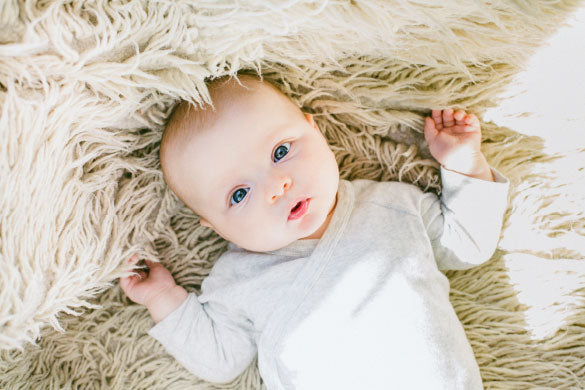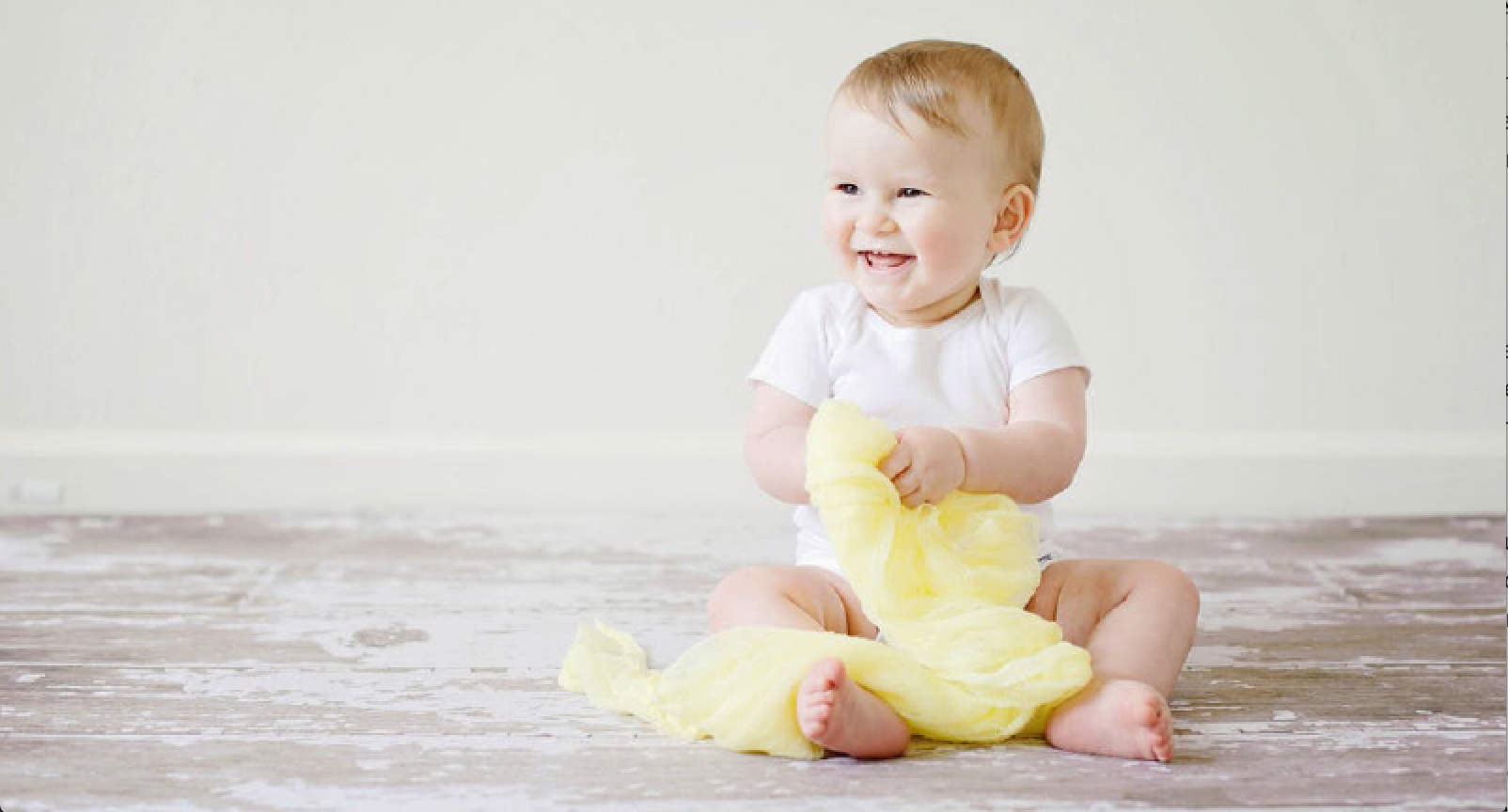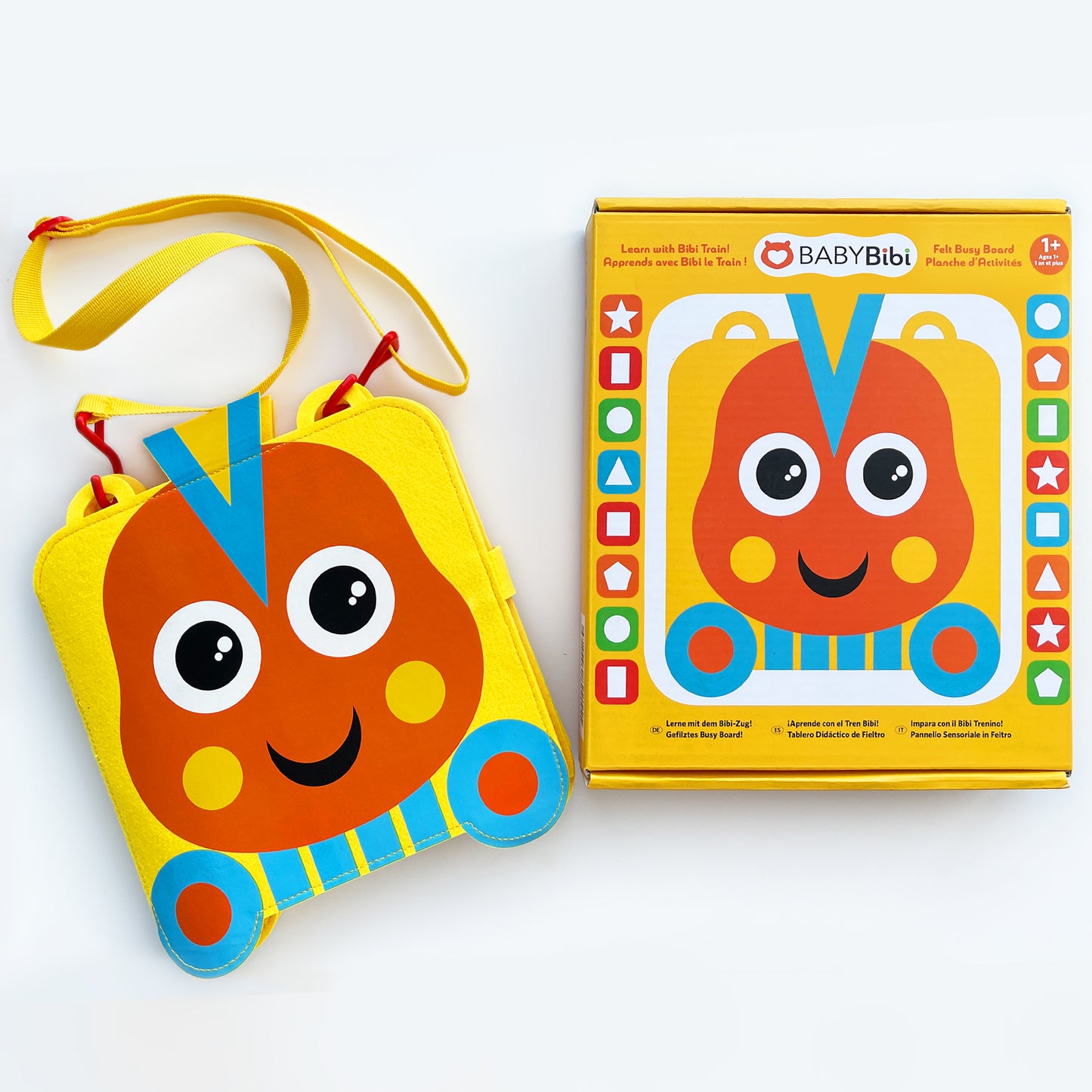
Your baby is 0-12 Months
Tummy Time
Young, energetic infants can’t get enough “Tummy Time.” This absolutely simplistic game or activity helps baby achieve basic motor coordination skills. It’s the greatest adventure to strengthen developing mus- cles as baby discovers an uncharted world. As early as birth, this “Boredom Buster” keeps baby alert and entertained while he or she is awake. An excellent way to incorporate “Tummy Time” is between changing nappies or diapers. A hard, comfortable surface provides seamless traction for baby to glide easily on the stomach. It’ll de nitely motivate baby to quickly achieve physical developmental milestones (sitting, crawl- ing, walking, etc.) early on.
Faces, objects, shapes, colors and other attractions to explore, “Tummy Time” takes baby on an exciting ash journey of observation. Heavy head? A determined baby certainly gets adults excited with the smallest achievements. Soon baby will learn arm support, scooting and roll over techniques to enjoy sightseeing more. With baby improving motor coordination, he or she will gradually make progress balancing the head. “Tummy Time” also allows room for creativity, so, adding additional elements of surprise will make explo- ration even more fun. Furthermore, it allows time for quality family bonding. Baby enjoys the company of faily and familiar faces, which makes “Tummy Time” an absolute selection for the occasion.
Family Handprints
Dads couldn’t anticipate a more heartwarming gift from baby. It’s an incredible family a air that helps the little ones explore crafts. Father’s Day handprints are the perfect keepsakes to complement a creative fam- ily album idea. Paper plates, cardstock and colored paint are all the materials needed to create beautiful Family Handprints with baby.
Who’s excited? Let’s get those hands messy! When playing, the family should arrange cards on a clean, pro- tected surface. Who has the biggest palm, dad? Great! Simply pour some of darkest paint onto the rst pa- per plate. After this, it’s time to get Daddy’s hands messy with paint and press them on paper. Repeat the steps for everyone and preserve their handprints, including that of the baby. The idea is to get the palm messy, making certain all ten ngers are coated too.
When all handprints have been preserved, it can be framed as a family keep- sake or presented to daddy on Father’s Day. Family handprints take baby on a magical sensory journey to self-discovery and explora- tion. With this activity, infants will enjoy sense stimulation through vision, taste, hearing, and touch. While embracing creativity, it helps baby’s brain and body integrate information. It also stimulates the self-ex- pression. It’s an engaging activity to incorporate as early as birth to baby’s rst birthday and can be per- formed indoors or outside.

Grabbing Basket
“Grabbing Basket” complements “Tummy Time “adventure wonderfully. This sensory experience allows strengthening of the neck and back as baby discovers basket treasures. So, get baby propped up on a pillow (s) while on the stomach for a developmentally enriching adventure. Everything to begin this adventure with baby are easily accessible around the home such as
a child-safe bin (shallow pan or basket) and toilet paper or paper towel tubes. The tubes should be cut into small rings measuring about an inch or 2.
The pattern of play is to put all the tube rings in the pan or basket bin and position baby propped up on pil- lows where he or she can grab treasures. Baby should be facing the pan or basket. Older infants can sit if they’ve already achieved this developmental milestone. Mummy or daddy can
let an older infant sit on the lap for “Grabbing Basket.”
Parents are allowed to explore ller variations as a means to make “Grabbing Basket” more fun. While toilet/ towel paper tubes make excellent llers, parents can nd creative ways to accessorize to the basket bin or pan for baby. For example, bath pu s, golf balls and ribbon strips, etc. With exposure to di erent articles, baby will not only enjoy meaningful tactile stimulation but also improve hand-eye coordination and sharpen ne motor skills (grasping/releasing).
On-Your-Feet!
Free play doesn’t get any more spirited and imaginative than “On-Your-Feet!” It’s particularly dedicated to crawling babies. Overall, this game help infants develop body awareness and enhance sensorimotor skills. It involves basic routines that infants can easily learn while on this thrilling sensory journey. The mode of play is to heap together a bundle of scrap textiles or fabric trimmings. Synthetic fur, a scarf (silky-smooth), tea towel or felt are all ideal for this occasion.
On-Your-Feet! allows personalized manipulation where a parent can either use the fabric to tickle baby’s un- der feet while he or she is propped upright or indulge an infant’s free-spirited crawling. Even infants nd cer- tain fabrics or textiles favorable. “On-Your-Feet!” provides adequate sensory exploration that will help baby develop tactile sensation naturally. Since infants are usually excited about the discovery
at age 3-6 months, incorporating On-Your-Feet! during this time will de nitely drive his or her motivation.
While indulging baby’s appetite for touching and exploring, incorporating di erent variations of textures and shapes is highly encouraged. Lace and velvet textiles are also agreeable choices to complement the fabric bundle. Some parents have gone to introduce other articles like ne sandpaper, cardboard and more. On- Your-Feet! will certainly elicit the cutest giggles and reactions as baby gets engrossed in playing this game.

So Big!
A classic lap game, “So Big!” packs a heavy dose of stimulating lessons that’ll keep baby grinning and en- gaged in interactive learning. It creates the perfect atmosphere to indulge the baby in early literacy learn- ing. Parent/child play is highly recommended for growing infants, and “So Big” builds on this premise. It’s become increasingly popular among millennial parents in pursuit of ways to help baby realize developmen- tal milestone achievements. Playing “So Big” is neither complicated nor daunting.
The motive of play is to elicit a reaction from baby. Parents usually take the rst session to get the baby in- terested in playing. Mommy or daddy should say “How big are you baby?” Followed by a response “So Big!” with arms raised up in the air. The steps are reasonably repetitive. Within weeks the baby will learn the steps and show progress with the “So Big!” routine.
Infants tend to react di erently when playing “So Big.” It’s expected since they’re on a journey of explor-
ing at this age. Nonetheless, parents should maintain the rhythm of play and try creative responses to get the baby involved. While they’re observant, infants don’t always react to stimulation immediately as their senses are still in developmental stages. Surprises tend to come when parents least expect it. The sensible course is to keep encouraging them.
Shadow Sharing
While infants’ sight is limited by immaturity, they’re sensitive to dark and light environments. A game of “Shadow Sharing” before nap or bedtime is appropriate simulation for younger infants. Visual tracking ex- ercises the eye muscles and is a core skill infants should develop. Time spent in the womb swimming ac- counts for baby’s enhanced night vision abilities. “Shadow Sharing” takes the baby on a familiar journey. With a ashlight beam hitting the baby’s room wall or ceiling create shadows of objects or forms that will easily distract baby. This stimulates curiosity that will eventually get baby to start tracking with the eyes. His or her visual tracking skills will improve with time as parents continue “Shadow Sharing” activities. Parents should maintain a reasonable pace when moving the ashlight beam to keep baby engrossed in play. Be- sides having limited vision, an infant’s attention span is also restricted.
As such, parents can include extra theatrics when playing “Shadow Sharing.” Since baby’s vision will become more pronounced at 6 or 9 months, this game idea works best for younger infants. Light exploration isn’t limited to playing with ashlights alone. Older infants can enjoy stimulation with
a natural light source such as the “sun.” Again, parents are asked to step up theatrics with creative play ideas. Ultimately, this game is a building block to sharpening vision skills.
Find It!
How about another fantastic activity that encourages quality parent/child bonding? Infants will have many birthdays, but the journey of the “ rst” is often celebrated di erently. When hosting a rst-year birthday party for baby, nding developmentally appropriate games and activities
is sometimes challenging. Find It! keeps the party lit, and doesn’t involve a tedious routine.
Although it’s recommended for party planning families, Find It! can be played at home with loved ones as well. Find It! is another sensorimotor game that challenges baby to discover hidden treasures. Be it baby’s favorite stu ed animal or rattles, Find It! promises an exciting adventure of problem-solving and analytical brainstorming. While the baby is seated in a high chair or on the ground/ oor, use a small towel or wash- cloth to cover toys (stu ed ani- mals, rattles, etc.).
Once baby realizes they’re hidden, he or she will reach for them. In any event, the baby isn’t thrilled about the idea, simply show him or her where the articles are hidden. This will naturally stimulate the baby’s inter- est to engage in play when the next round starts. With repeated exposure, baby’s problem solving and intu- itive thinking skills will gradually improve.
Listen Up!
Sound stimulation games get the baby excited as his or her hearing becomes attuned to changes in tones, speech patterns and so on. Listen Up! accomplishes auditory awareness as the baby learns di erent sounds. It’s quite similar to a game of “Find It” but with incredible attention placed on baby developing auditory senses. As usual, creativity counts, so parents should think of interesting ways to make sound exploration fun for baby. Be it chiming bells or rattles, baby enjoys hearing stimulating sounds. When playing Listen Up! a single chime of the bell will get baby looking and send the senses exploring.
As the baby is trying to determine what’s making the sound, show him or her the bell before ringing it again. Once baby has eyes on the bell, slowing hide it or cover it with a washcloth and asks baby “Where
did it go?” Keep Listen Up! fun by changing locations each time the bell is rung and revealed. And with every interaction, the baby should have eyes on the bell before it’s rung again. The golden rule is to keep always allow baby to follow the sound of the bell. This requires active listening skills, which baby will learn to ampli- fy with repeated exposure to auditory stimulation lessons.
Get Out Your Umbrella!
The skill of self-awareness is usually developed when infants transition to toddlers. However, Get Out Your Umbrella! prepares them for this cycle early on. The game heightens their perception of individualism with parents incorporating this play activity regularly. From tickling pompoms to sing-along sessions, the baby will become engrossed in this sensory experience. With kicking legs and arms, gummy smiles and eyes like searchlights, the baby will request more Get Out Your Umbrella!
Classic numbers like “It’s Raining, It’s Pouring” will easily get the baby rocking to the tune and babbling incessantly. Some infants will catch on quickly to singing songs. After ending the song, cover baby’s chest and belly with colorful pompoms and observe his or her reaction. It’s time to Get Out Your Umbrella! The emotions of playing this game for the rest time will range from crying baby to cheering baby. All this will change as baby discovers the secrets to playing Get Out Your Umbrella!
Besides sensorimotor exploration, Get Out Your Umbrella! is a bu er for the baby developing core language skills. Parents can introduce this language building game as early as three months. It can be incorporated during bath time to keep baby engaged in fun learning and play.
Hi! Bye!
Is baby approaching 6 - 9 months? It’s the right time to introduce Hi! Bye! They’re usually already attuned to the mysteries of Peek-a-boo, so this game called Hi! Bye! is an excellent addition to Improve baby’s natural language skills. Infants are mostly absorbed in playing Hi! Bye! as they’re exploring words, sounds, and ac- tions. Imagine baby’s reaction when he or she sees funny pop up faces. Parents should consider using both hands and a towel to cover the face and pop up saying Hi! to the baby. This will get the baby chuckling and giggling. Before disappearing, say “Bye!” while waving.
Language learning supports parent/child interaction and improves communica- tion. With growth and prac- tice, the baby will learn word meaning
and develop an understanding of actions. Some infants tend to be less inclined to interact or exhibit shyness. Hi! Bye! helps them overcome shyness and develop self-condence when communicating with others, be it, social peers or adults.
Hi! Bye! creates the right atmosphere for learning sound/object relationship while developing primary language skills. Input is key when on a language learning journey with the baby. Most infants won’t necessarily repeat words immediately after hearing it. With practice, the baby will eventually form words and can understand what each one means.

